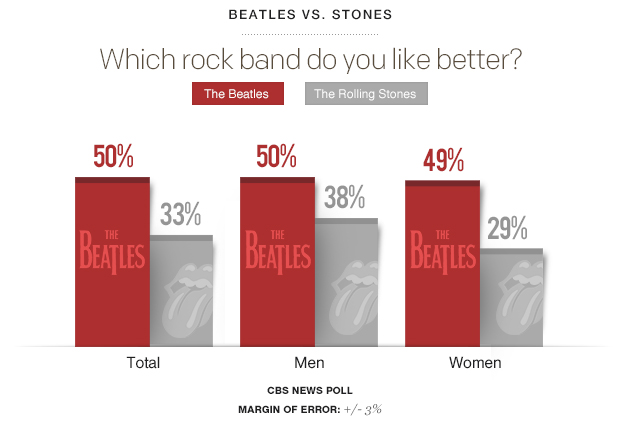Age-old debate: Beatles vs. Stones
This piece by John McMillian is part of a series of essays to mark the 50th anniversary of the Beatles' first American television appearance on CBS's "The Ed Sullivan Show." It culminates with CBS News, 50 Years Later...The Beatles at The Ed Sullivan Theater: Presented by Motown The Musical, a live, multimedia event at The Ed Sullivan Theater on Feb. 9.
In order to share in the type of the success the Beatles were having, (Rolling Stones manager Andrew) Oldham insisted that the Stones make some image and personnel adjustments. On the theory that six members was at least one too many for a successful group, Oldham made them kick out pianist Ian Stewart - who anyhow had too square a jaw for Andrew's liking. Keith Richards was bizarrely instructed to drop the "s" from his last name; Keith Richard, Andrew said, "looked more pop." Meanwhile, he added a "g" to the band's name, making them the Rolling Stones; otherwise, he said, no one would take them seriously. Twenty-six-year-old Bill Wyman was told to begin pretending he was twenty-one. But most significantly, Oldham persuaded the band to loosen up its performance. Though Jones still postured himself as the group's leader, Andrew recognized Jagger's electric appeal, and insisted that he share in the limelight.
- Complete coverage of The Beatles: 50th Anniversary
- CBS News Poll: The Beatles (PDF)
- WATCH LIVE: "50 Years: The Beatles" Sun., Feb. 9, 6:30p ET/3:30p PT
- More on the Beatles from CBS Local
- Win tickets to the live event at the Ed Sullivan Theater on Feb. 9
The following month, though, when the Stones embarked on their first national tour (sharing a spectacular bill with Bo Diddley, Little Richard and the Everly Brothers), they began wearing their outfits in a more slovenly style. One night, Charlie Watts unexpectedly doffed his waistcoat in a Fenland dressing room; eventually Keith Richards' jacket grew so bespotted with chocolate pudding and whiskey stains that it was no longer wearable. Onstage, the whole group started moving more, and Jagger took to chewing gum as he sang. Offstage, a journalist observed, they appeared in "a jumbled assortment of jeans, silk cardigans, camel jackets and sloppy sweaters. None of the slick suits sported by Bill J. Kramer Gerry and the Pacemakers." When the Stones appeared on a BBC program in October 1963, they frustrated their interviewer by greeting many of his questions with simple "yeah's" and "no's." But rather than hurting their popularity, all of this seemed to boost their appeal! Their audiences were becoming more demonstrative, more raucous, to the point where the Stones, just as soon as they finished their sets, were forced to flee their venues through the back door and speed off as quickly as possible to avoid getting mobbed. Without ever devising or articulating a formula for instigating a cultural revolt, the Rolling Stones began to stumble upon one.
He "made sure we were as vile as possible," Mick acknowledged. "Andrew pitched it so we were very much the antithesis of the Beatles." Of course, the Stones proved masterful at projecting arrogant, sour attitudes. Surely Jagger was deploying his best Cockney-put on when he told an interviewer, circa 1964: "If people don't like us, well that's too bad. We're not thinking of changing, thanks very much. We've been the way were are for much too long to think of kowtowing to fanciful folk who think we should start tarting ourselves up with mohair suits and short haircuts."


